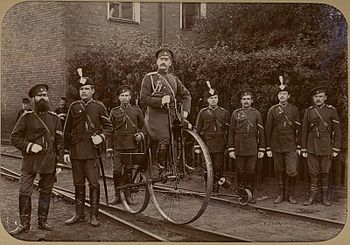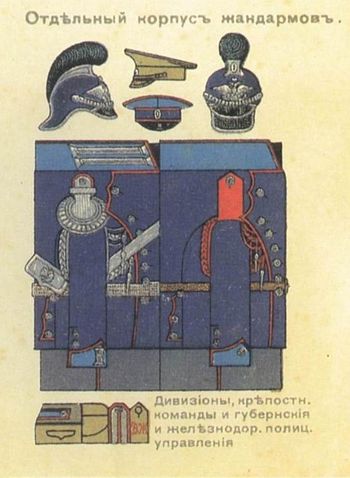
Russian Gendarmes, 1890

Uniform of gendarmes 1911
The Special Corps of Gendarmes (Russian: Отдельный корпус жандармов) was the uniformed security police of the Russian Empire in the 19th and early 20th centuries. Its main responsibilities were law enforcement and state security.
The responsibilities of the Gendarmes also included the execution of court orders, pursuit of fugitives, riot control, and detainment of "unusual" criminals. Gendarmes could also be assigned to assist local police and officials.
Historical Development[]
The precursors of the Corps were the Army Gendarmerie regiment, created in 1815 and based on the Borisoglebsk Dragoon Regiment, and Gendarmerie units of the Special Corps of the Internal Guards. Following the 1825 revolt, the new tsar, Nicholas I, created the office of the Chief of Gendarmes in July 1826 and appointed General Count Alexander Benkendorf to it; all of the Gendarmes were subordinate to the Chief. Benkendorf was also appointed Executive Director of the newly created Third Section of the Imperial Chancellery, although the office of the Head of the Third Section was not formally merged with Chief of Gendarmes until 1839.
In 1836, the Gendarmerie of the Internal Guards was transformed into the Special Corps of Gendarmes, under the Chief of Gendarmes. The Commander of the Corps and Chief of Staff of the Corps were also Directors of the Third Section under the Executive Director. The Corps was divided into seven territorial Districts, six of them located in Russia and one in the Kingdom of Poland, each having a Directorate. The Main Directorate, along with additional Gubernial Directorates, was also created. The Army's Gendarmerie regiment joined the Corps in 1842. The Gendarmes used Cavalry ranks of the Russian military ranks system introduced in 1826. Most branches of the Special Corps wore light blue uniforms in contrast to the dark green of the regular army and police. Gendarmes of the Railroad Directorates were however distinguished by dark blue tunics.
As of 1867 statute, the Corps consisted of:
- Main Directorate
- Surveillance staff
- Caucasus, Warsaw and Siberia Districts
- Gubernial Directorates (56)
- Uyezd Directorates (50)
- Railroad Directorates
- St. Petersburg, Moscow and Warsaw divisions
- Mounted units (13)
In 1871, the Gendarmes acquired the right to investigate both political and criminal cases, as the judicial investigators were dismissed.
Only the most competent of the Army's officers in noble ranks could join the Corps of Gendarmes. Although the Corps maintained a powerful image, its large network of informers and agents often supplied nothing more than rumors and slanders; the Gendarmes were obviously incapable of infiltrating real revolutionary organizations. In August 1880, both the Third Section and the Special Corps of Gendarmes were transferred to the authority of the Minister of Internal Affairs by proposal of Count Loris-Melikov. The office Chief of Gendarmes was inherited by the Minister, and the Commander of the Corps became his Deputy. Many Gendarme officers were transferred to then-created Department of Police.
Following the 1902 assassination of MVD Minister Sipyagin, the state security power of Gendarmerie Directorates was transmitted to the Okhrana and counter-intelligence units of the General Staff and the Department of Police.
During the Russian Revolution of February 1917, gendarmes stationed at Kronstadt remained loyal to the Tsarist regime, firing on demonstrators and subsequently being imprisoned for trial.[1]
Heads[]
- Alexander von Benckendorff (1826–1844, its founder and first chief)
- Vasily Andreyevich Dolgorukov (?-?)
- Aleksandr Potapov (1861–1864)
- Pyotr Andreyevich Shuvalov (1866-?)
- Alexander Drenteln (1878–1880)
- Pyotr Dmitrievich Sviatopolk-Mirskii (1900-1905)
Citations[]
- ↑ Pitcher, Harvey. Witnesses of the Russian Revolution. pp. 105–106. ISBN 0-7126-6775-X.
References[]
Political police and political terrorism in Russia (second half of XIX - beginning of XX). Collection of documents. Compiled by V.I. Kochanov, N.N. Parfyonova, M.V. Sidorova, Ye. I. Sherbakova. Moscow, AIRO-XX (2000). ISBN 5-88735-079-2. (In Russian). [1]
External links[]
See also[]
- Ministry of Police of Imperial Russia
The original article can be found at Special Corps of Gendarmes and the edit history here.